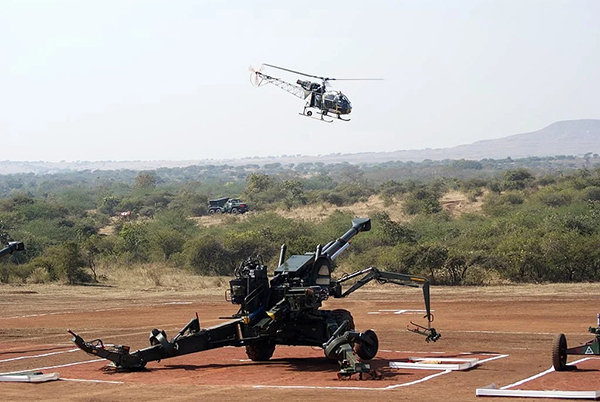
Two Dhanush artillery guns, having a strike range of 38 km, fired 90 rounds each “flawlessly” during a test at the Pokhran firing range in Rajasthan on March 8.
According to reports, the test was part of the second line of firing in Zone 6. Second-line of firing means the firing of guns through ammunition replenishment of 45 rounds each continuously, while zone 6 refers to the highest charge, which makes the gun to fire at its maximum range.
The barrel gets very hot in this process and may burst, which is why the successful firing showed that the gun is now ready for active deployment, the report said.
India has increased procurement of indigenous weapons systems as part of the ‘Atmanirbhar Bharat’ (self-reliant India) initiative, as part of which the country has successfully created an artillery ecosystem capable of designing and producing 155 mm howitzer.
The Ministry of Defense (MOD) has banned the imports of 155 mm guns after December 2021, as part of its indigenization drive. Over the past few years, private sector companies such as Larsen & Toubro (L&T), Tata Advanced Systems, Mahindra Defence and Bharat Forge have set up gun production lines.
Private Sector Joins The Race
L&T has built and delivered 100 155 mm K9 Vajra guns under a transfer of technology (ToT) arrangement with South Korea’s Hanwha Defense, and plans are afloat to place orders for more.
K9 Vajra guns, as reported by EurAsian Times, have been deployed along the Ladakh border in response to the Chinese PLA’s Xinjiang Military Command fielding new artillery systems, including the PCL-181, PCL-161, and PHL-03 MLRS.
Mahindra Defence is building 120 BAE Systems’ M777 light-weight howitzers in India, and three regiments of the gun have been deployed near the India-China border. Bharat Forge has developed towed and truck-mounted guns such as Bharat 52 and MSG 155.
But, of late, India’s artillery modernization program has hit numerous roadblocks. The 155mm/45-calibre Dhanush and 155mm/52-calibre Advanced Towed Artillery Gun System (ATAGS) have suffered a series of setbacks.
The successful firing of Dhanush guns on March 8 means that all decks have been cleared for its induction.
Meanwhile, the ATAGS, being developed by the Defence Research and Development Organisation (DRDO) along with private firms Bharat Forge and TATA Power SED, is set to undergo its last round of test-firing that will begin in March.
Dhanush is a towed howitzer with a strike range of 38 km, developed on the basis of the first phase of the ToT deal under the Bofors contract of the late 1980s.
The Indian Army had ordered 114 x Dhanush guns in 2019 with the production beginning in the same year. The induction of Dhanush into the Army commenced in April 2019 but an inquiry by the Central Bureau of Investigation (CBI) found that the ‘Wire Race Roller Bearings’ of the six Dhanush guns supplied to the Army had ‘not’ passed the quality tests at the Guns Carriage Factory (GCF), Jabalpur, and production was halted.
During the trial by the Directorate General of Quality Assurance (DGQA) in mid-November 2020, the recoil system of the gun failed. Between 2019 and 2021, only 12 of the long-range Dhanush guns have been delivered to the Army.
While the ATAGS is a towed 155 mm/52-caliber howitzer that can fire the Extended Range Sub-Bore Boat Tail (ERFB BT) ammunition at a range of 35 km and the ERFB BB (Base Bleed) ammunition at a range of 45 km.
The ATAGS can fire five rounds in a minute as compared to the legendary Bofors FH-77 and the rest of the guns in the world that can fire only three.
The ATAGS project started in 2012 and has been getting delayed due to its failure to meet the parameters set out by the Indian Army. During an evaluation trial in September 2020, the ATAGS suffered an accident of its barrel burst that left four soldiers injured.
Officials say the complete order for 150 modern ATAGS guns is likely to be completed only by 2026, which may still be ambitious. Bharat Forge and TATA Power SED will get orders, with the lowest bidder reportedly getting the largest share — 60 percent or more.
For almost two years now, Indian and Chinese troops have been locked in a border standoff in eastern Ladakh, at an elevation of about 15,000 feet above sea level and amid freezing temperatures.
In that context, India is ramping up its artillery to meet the challenges of ‘maneuver warfare’ or ‘fluid’ warfare’, which involves difficult ground movement by an infantry battalion in a rugged landscape with support of precise firepower capable of destroying enemy bunkers and hideouts that can otherwise disrupt this movement.

















